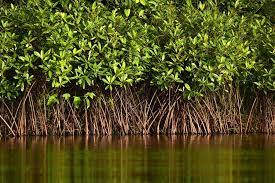Magical Mangrove Forests
- Alyssa Allen

- Mar 8, 2021
- 3 min read
Hello my fellow curious critters and welcome back to The Friendly Neighborhood Shark Lady! Today I am branching off from my usual animal topics and opting to talk about some trees today. If you know me, you know botany wasn’t my best class (I’m sorry, I know plants are super important, but animals are just so much more interesting to me), but today’s topic is an important one. Today we are exploring the marvelous world of mangrove forests and why they are so important.
As always, let’s start with the basics. What exactly is a mangrove forest? Mangroves are groups of different trees and shrubs that grow in coastal intertidal zones. There are between 50 and 110 different mangrove species depending on who you ask. They are some of the only plants that are adapted to living in saltwater and low oxygen soil. You will only find them in tropical and subtropical areas, though. Mangroves cannot withstand freezing temperatures well. They are easily recognized by their tangle of roots that make the trees and shrubs appear to be standing on long, skinny legs above the water. This allows them to withstand the daily tide cycles where they are flooded twice a day at high tide.
So, why are mangroves important? I’m glad you asked, because there are many reasons. One of the biggest advantages for humans is that they help protect the coast from storms and erosion. Their complex root systems grab hold of soil and prevent it from being washed away by rain or the tide. Mangroves’ above-ground roots slow down the flow of water and encourage sediment in the water to settle to the seafloor which, in turn, further prevents coastal erosion. During extreme weather, like hurricanes, they also help protect the coast from damaging storm surges. A recent study has shown that in the United States alone, mangrove forests provide more than 65 million dollars worth of flood protection every year.
Mangroves also provide essential nursery habitats for thousands of marine animals. Many species of sharks, which we all know are near and dear to my heart, as well as other marine fishes, spend their entire juvenile lives in the protection of the mangrove forests found around the world. Without the protection the mangroves provide, many of these species would see a dramatic decrease in their populations. Mangroves also provide important habitat for many species of adult seabirds and even some terrestrial species. Oh, and you can’t forget about the sea sponges, mussels, oysters, sea turtles, and manatees that also greatly depend on mangroves. Long story short, a tremendous number of species depend on mangroves for food, habitat, and protection to survive.
Another wonderful thing mangroves do for us is act as carbon sinks. As the trees and shrubs that make up the mangrove forests grow, they absorb carbon from the carbon dioxide in the air to use as the building blocks for their roots, branches, and leaves. Once the tree or shrub loses its leaves or dies, they fall and are buried by the seafloor. The carbon that they absorbed from the atmosphere over the years as they grew is also buried with them and becomes what is called blue carbon. Blue carbon is carbon that is stored underwater. Over the course of one year, one acre of mangrove forest can store about 1,450 pounds of carbon. Globally, it is believed that mangrove forests store around 75 billion pounds of carbon annually.
Why does it matter that mangroves store carbon from the atmosphere? Well, carbon dioxide is a major greenhouse gas that contributes to global warming and climate change. Greenhouse gases capture heat from the sun that would normally be reflected back out into space and trap it in the earth’s atmosphere. This causes the temperature of the earth to rise as a whole. The more carbon we can remove from the atmosphere and store underground, or underwater, the better.
Unfortunately, we are losing our mangrove forests at an alarming rate. Some studies suggest that we have lost around a third of the world’s mangrove forests in the last few decades. They are most at risk due to human activities. We have been clearcutting them to make way for coastal development, polluting the waters with herbicides, and clearing them to create shrimp farms. Sea level rise, ocean acidification, and other environmental factors attributed to climate change also greatly put mangrove forests at risk for destruction. There is hope, though. Many scientists are working hard to protect, preserve, and restore the world’s mangrove forests.
Thank you for coming along and learning with me today! I always knew mangroves were important, but I really enjoyed learning more about them today. What surprised you the most? I know my mind was absolutely BLOWN when I learned just how much carbon they remove from the atmosphere every year. I hope I will see you all back here soon for more science fun!
Sources:










Comments